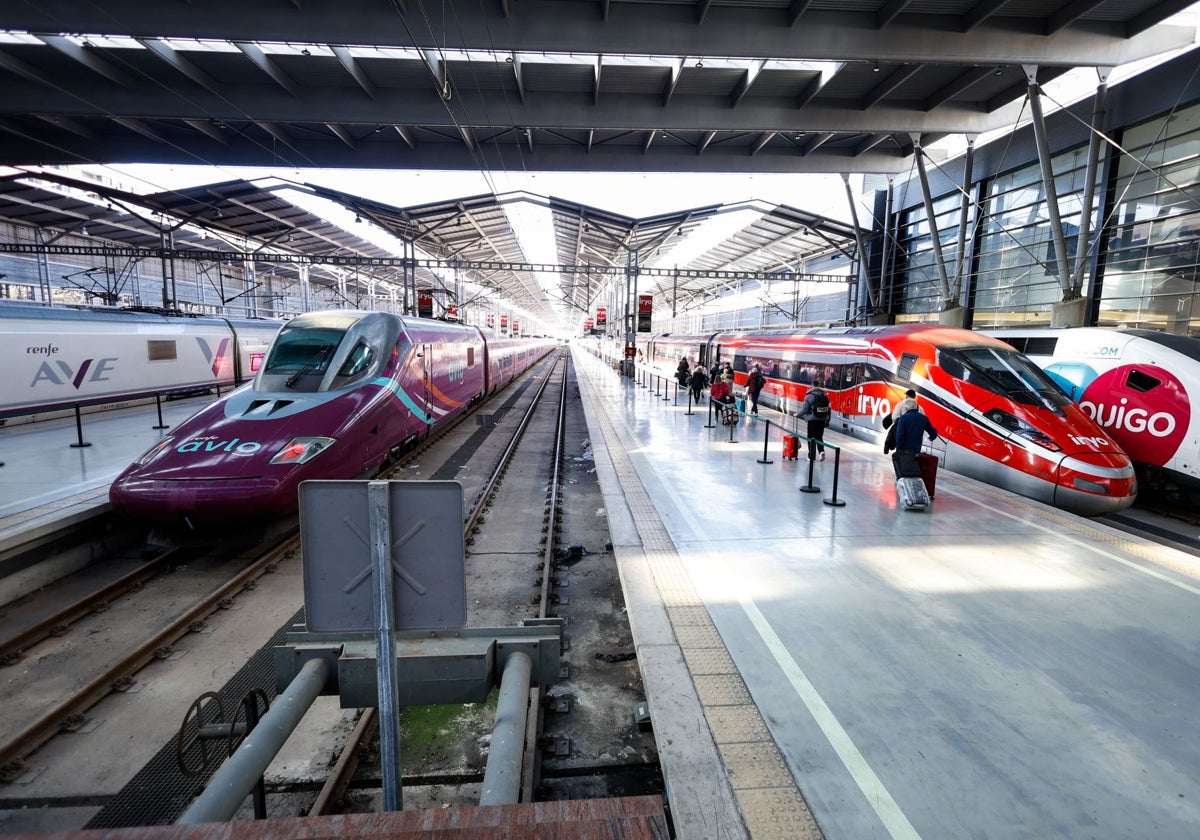Monday, 4 August 2025, 14:11
The freeing up of competition within the high-speed rail market continues to set new milestones in Malaga city on the Costa del Sol. The arrival of competition from private train operators Iryo and Ouigo, coupled with Renfe’s response to that challenge, has led to the largest ever selection of rail travel options for city connections across Spain. Not only that, but the extra services added this summer have now made Malaga the city with the third highest number of high-speed, direct train connections with the Spanish capital, Madrid.
This figure refers only to point-to-point connections, that is, the start and end points of the route. Therefore, it does not take into account any of the through stations such as Cordoba and Zaragoza, which logically have more stops because many services and lines converge in those places.
Currently, the capital of the Costa del Sol has 25 departures in each direction, according to a comparative search carried out by SUR on 30 July, for travel on Friday, 1 August. This is also a particularly important date, as it marked the start of the main summer holiday period for millions of people across Spain.
This number (25) means that, for the first time in the history of high-speed rail travel in Spain, Malaga surpasses the Andalusian capital of Seville in terms of the number of train departures. Alicante is also far behind. Currently, therefore, Malaga’s María Zambrano railway station only has fewer trains in operation than Valencia-Joaquín Sorolla station (not far off each other) and Barcelona-Sants station, which has a much larger selection, so well ahead of the other two cities.
If we consider only the connections provided by the two private operators, which are governed solely by criteria of anticipated commercial demand (and not public service), Iryo has its third-largest selection in Malaga (seven daily connections). Ouigo has Malaga tied with Alicante for the same number of train departures (three), while Barcelona and Valencia each have five.
These figures reflect not only the tourist potential of Malaga and the Costa del Sol during the summer, but also their growing demographic and economic importance, given that many business owners, the self-employed and employed workers residing in the province have to travel frequently to the Spanish capital for work reasons.
Malaga-Madrid
In detail, the scenario by city with all the existing operators is as follows. In the case of Malaga, state operator Renfe offers 12 AVE services (the most common) and three Avlo services (its low-cost version). Meanwhile, the Spanish-Italian operator Iryo offers seven departures and the French operator Ouigo, three trains in each direction (25 in total).
Seville-Madrid
Turning to Seville, which was the first high-speed line to open in Spain and has always had superior services to Malaga, the situation is more complex now in the summer. Initially, Renfe nominally has nine AVE and three Avlo connections. However, to be fair, we must add three more Alvia services and one Intercity service, which have similar journey times to the Spanish capital. Therefore, the public operator has 16 connections in total. Iryo has five and Ouigo two. The total number of trains per day at Santa Justa is 23.
Alicante-Madrid
The comparison with Alicante is important, as it is another coastal city with an significant metropolitan area, a direct competitor of Malaga and the Costa del Sol in the tourism sector. In this case, however, the rail service provided is clearly lower. Renfe offers 11 AVE trains daily, plus two Avlo and two Alvia. Iryo has two and Ouigo three, making 20 in total.
Valencia-Madrid
Something similar occurs with Valencia, in terms of city type. At the top of the table, above Malaga in terms of number high-speed services, there are only two large Spanish cities, one of them being Valencia, where Renfe runs 11 AVE, three Avlo and one Intercity services. Iryo provides eight services and Ouigo five. In total, there are 28 connections.
Barcelona-Madrid
This is undoubtedly the most important rail link in Spain, with no fewer than 35 fast connections every day. Of these, 13 are AVE (including one International AVE) and five Avlo (both from Renfe). Meanwhile, Iryo has 12 and Ouigo five.
There are still places available for last-minute rail travel this summer
With the largest ever supply of trains running for city connections in Spain, it is logical that prices will be lower. This is indeed the case, but not always. If you book well in advance, you can secure very cheap fares, from 10 to 20 euros each way, or even less. Also, since all operators’ pricing systems are dynamic, it is normal for fares to be cheaper on days with less demand, especially for travel from Monday to Thursday.
However, if you book at short notice, prices skyrocket, especially for the big departure and return days for the holidays.
What is quite a novelty is that, at the time of writing, there were still a plentiful supply of seats available for the most important dates in August and they are generally cheaper than last year (although much more expensive than if they had been purchased in advance).
For the same search that served as the basis for the comparison of trains by province, that is, on Friday 1 August (conducted last Wednesday 30 July), there were still seats available with almost all operators and on most departures, something that was not the case last summer. However, you would have to pay between 52 and 121 euros per person per journey to travel with Renfe, between 54 and 109 euros with Iryo and between 65 to 75 euros with Ouigo.

